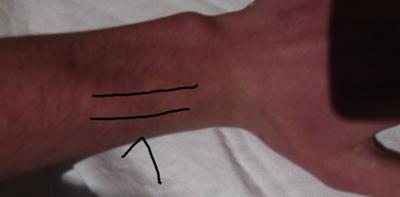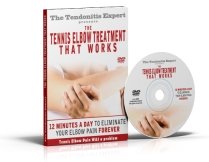Ongoing wrist tendonitis for over a year from playing Guitar (and drums)
by Matt
(Australia )

Tendon pain from playing guitar, back of wrist, image picture
I started playing guitar about one and a half years ago, and a couple of months after I started I developed tendonitis in my wrist.
I believe the guitar caused the tendonitis, and more specifically, the pushing on the back of the fretboard with my thumb. (I am 17)
I have had ongoing tendonitis since then, and it is now become chronic.
I have tried to show the pain area in the photo.
It is the large tendon that runs up the arm on the inside of my left arm. The area is not as swollen as it was when it was at it's "worst" and there is a thickening of the tendon in the area.
(I think it is where some of the tendons join) The pain is only mild, and bearable, but i have had it for over a year now and it has not gone away.
There is also a lot of clicking in the wrist when i rotate it, or move it. It feels weird all the time and i have to squeeze the wrist and then move it around until the clicking stops, and then it feels normal again.
When I play guitar for an extended period of time, the underneath of my wrist feels tight and tense, and it can ache.
As I said above, I am pretty sure that it is the pushing of the thumb action (almost like pinching) that is the problem, as well as the bent wrist that is required to play the guitar.
The pain can also extend up the arm as well (almost to the elbow) at (bad) times.
I am not sure what to do. Do you think the ice bath method will help even though it is not acute and swollen? (I have not tried it yet, but i did ice it in the past when it was bad)
Also how many times do
The tendonitus seems to have settled into a constant state, with no sign of improvement, and I really want to fix it so i can play guitar more.
Thanks Matt
----
Joshua Answers:
Hi Matt.
Ice dipping will absolutly help. A minimimum of 10 times in the two hours. And, if you're home all day on a weekend, keep an ice bath going and dip all day long.
You may want to Ice Massage as well. I would.
Drumming helped create a scenario such that when you started playing guitar, your forearms started to quickly get less and less happy.
Thanks for the picture. I suspect that part of this issue is not just the thumb action, but I bet you cock your wrist back in some manner while playing, yes? Or potentially forward. Or both, depending on what you are doing.
Pay attention to and modify this action. Don't cock the wrist too much, and don't hold it for too long.
And train yourself to keep your muscles as relaxed as possible while you play.
Too much strain causes Tendonitis symptoms.
Were I you I would also increase my nutritional intake.
Less sugar. (it steals nutrition from your body.)
Supplement with Magnesium for Tendonitis
And Bone Broth as the best Tendon Supplements
Oh, also, regularly massage the forearm muscles throughout the day. Too tight muscles constantly put tension on unhappy tendons.

Joshua Tucker, B.A., C.M.T.
The Tendonitis Expert
www.TendonitisExpert.com
| |
| Share Your Story |
Comments for Ongoing wrist tendonitis for over a year from playing Guitar (and drums)
|
||
|
||
|
||
|
||



